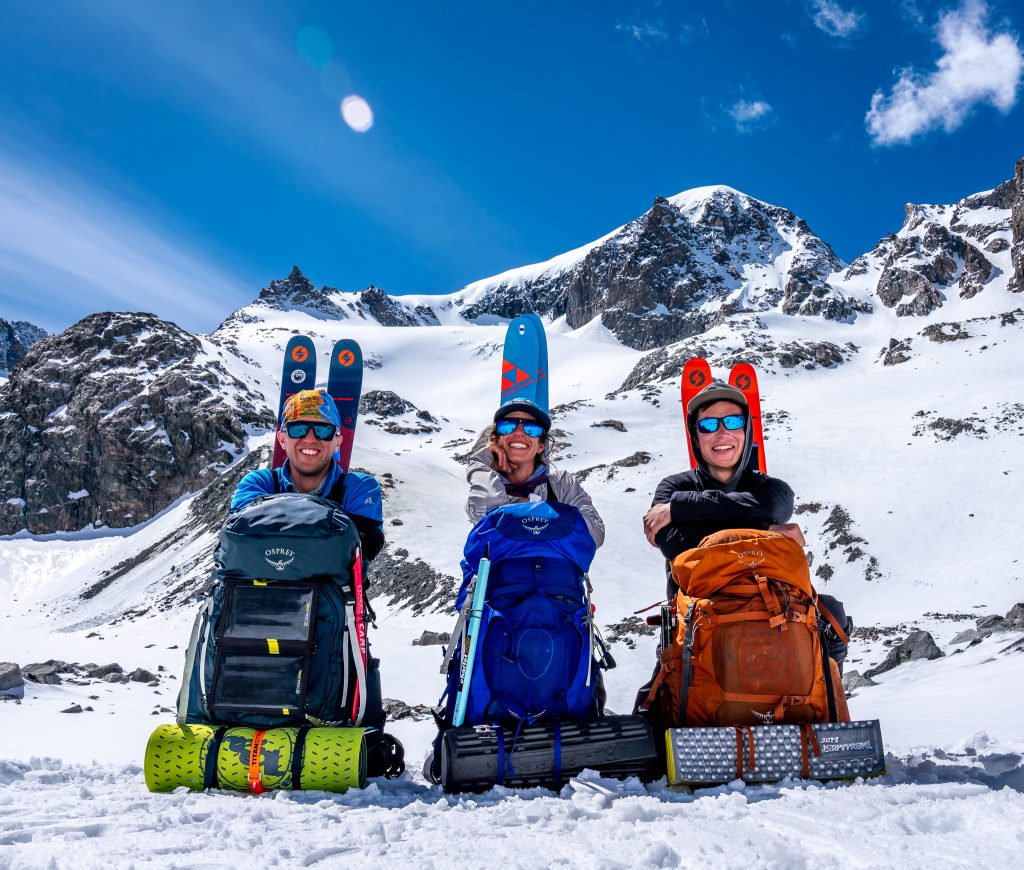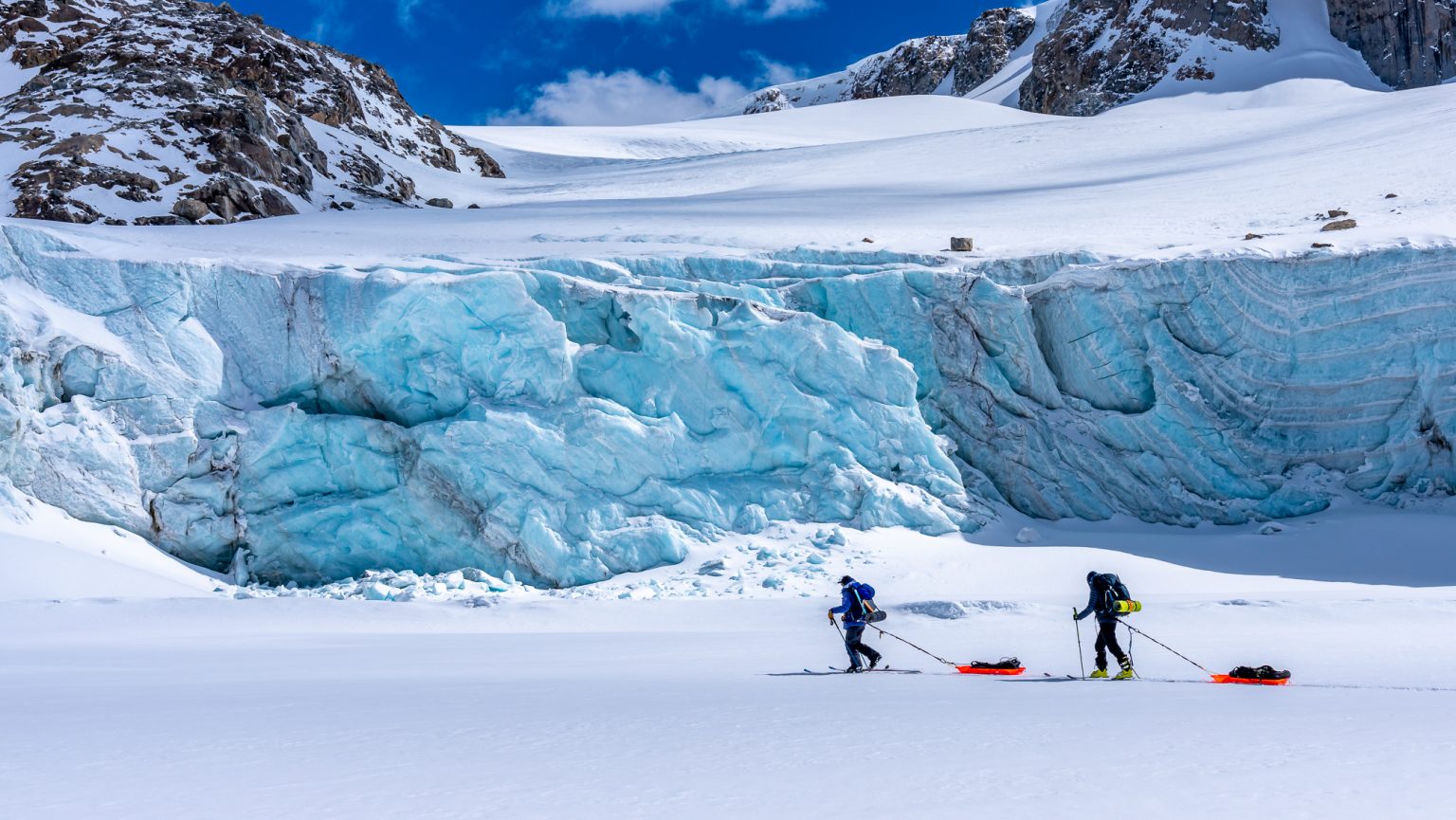On May 15, 2020, Uphill Athlete Iain Kuo and two companions completed a two-week ski traverse across the length of Wyoming’s greatest mountain wilderness, the Wind River Range, covering more than 115 miles and 32,000 vertical feet of ascent on foot. Along the way they skied from the summit of Gannett Peak, the state high point.
by Iain Kuo
When Life Gives You Lemons
I was picking my way through breakable crust in the treed foothills near the base of Mount Moran in Grand Teton National Park when we got the news. As every backcountry skier, mountaineer, and wilderness adventurer knows, a full disconnect from the outside world is one of the great benefits of any multiday foray into the wild. That said, it pays to keep a satellite communicator on hand during such trips in case of emergency.
The day before, my friend Sophia Schwartz and I had crossed Jackson Lake, still thick with ice and snow in the early spring, sliding on skis and dragging sleds full of food and camping gear. We were aiming to take a shot at some of the less frequented ski lines in the more remote northern end of the park. The one exception would be the Skillet. Despite being relatively tough to access without a late-season boat ride, the Skillet is one of the most coveted lines in the Teton Range. Popularized in Fifty Classic Ski Descents of North America, for locals it needs no introduction—it can be seen for miles across the valley, a behemoth of a couloir carved proudly through the cliffs buttressing the eastern face of Moran.
Since moving to Jackson, this would be my third attempt on the Skillet in as many years. The name derives from the general shape of the line; the upper couloir, long and straight, opens into a wide, roughly circular glacier in the lower half, thus creating the shape of a massive frying pan. Just over two years prior, I had learned firsthand another reason why the name is so apt—under the heat of a blazing sun in a clear Wyoming sky, the glacier and overhanging cliffs heat to a dangerous temperature in the early morning. Linger too long and you are likely to be burnt, as evidenced by the ever-present wet slide debris across the face of the glacier in spring.
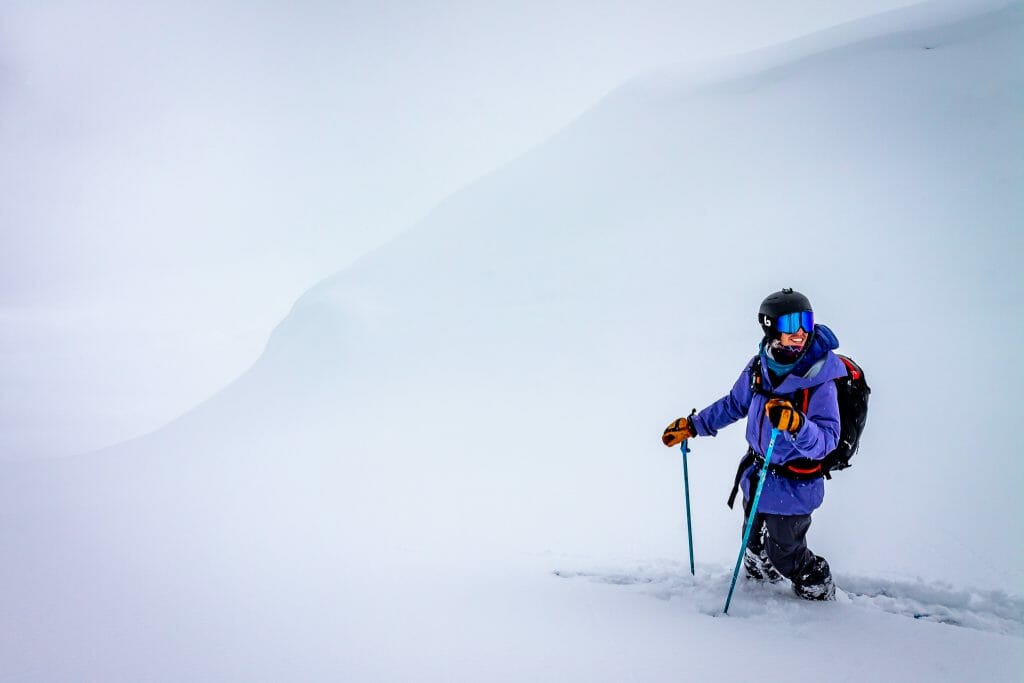
Sophia and I encountered nothing like those typical spring conditions, however. For hours we set the skin track followed by a knee-to-thigh-deep bootpack up nearly 6,000 vertical feet from the lakeshore, almost entirely in whiteout conditions. We weren’t graced with the stunning view of the sunrise over the icy lake that I had witnessed in years past, nor a glimpse of the majestic pyramidal peaks of the Cathedral Group to the south. We were, however, rewarded with thousands of feet of untracked, stable powder skiing. Had I been able to see where I was going, it would have been all-time fun. Nonetheless, having been denied within a thousand feet of the summit two years running, redemption on one of the great classics standing above the beautiful valley I call home felt oh-so-sweet.
The inReach buzzed. Nearing our campsite on the lake, Sophia and I took a break from trying to stay on top of the treacherous surface crust that had formed among the low-elevation pines. The message was from Ian Johnston, the third member of our merry band of ski adventurers. Sophia and I exchanged a smile. Ian would have been out there with us, but we had departed on a Thursday in order to maximize our possible ski days over a long weekend. When Ian wasn’t around, Sophia and I would often marvel at his ability to consistently crush lines with big vertical gain, despite working a full-time desk job and largely being restricted to weekend warrior status. I suppose it’s in the blood when you’re Jackson Hole born and raised.
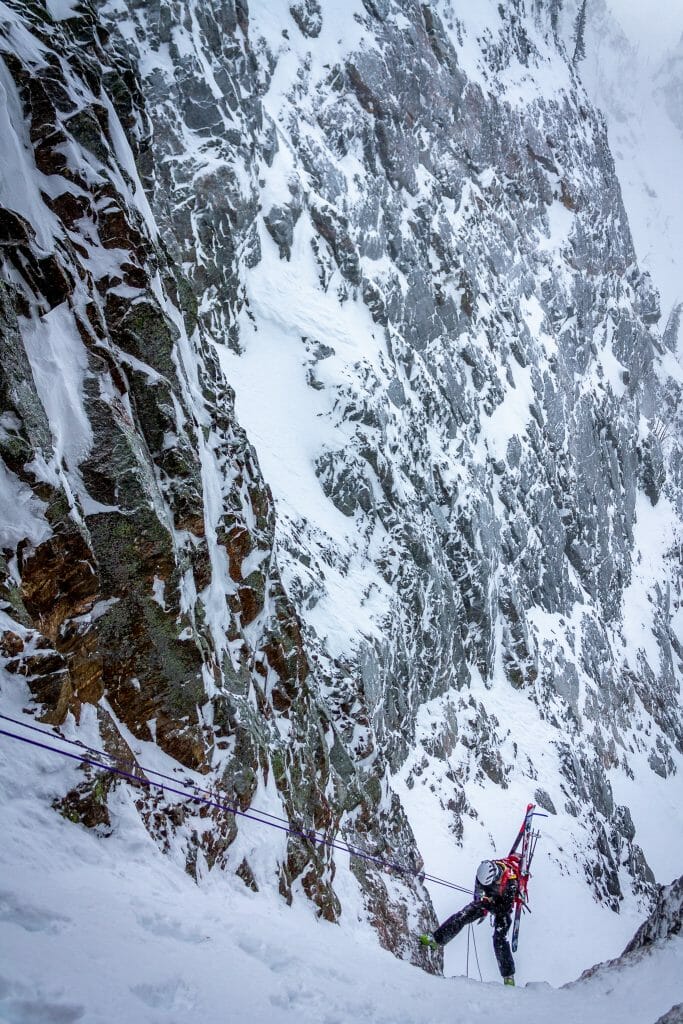
Throughout the season, the three of us had been meeting at least once weekly at Ian’s apartment to practice essential skills for an upcoming attempt to ski from the summit of Denali without a guide. Roping up for glacier travel, rigging sleds for pulling heavy loads, mastering crevasse rescue gear and systems—week after week, we went over route-finding to meal planning and everything in between. Even coming out to the northern end of the park this weekend had been with winter camping practice in mind. And despite the laundry list of skills essential to survival on a peak like Denali, priority number one often became heading into the Tetons to ski steep, technical couloirs, ideally with at least one mandatory rappel. These group sessions rarely felt like a chore, to say the least.
“Bad news team – Denali just canceled climbing season.” The message concluded with a sad-face emoji.
“Ouch, that hurts,” I mumbled.
“Yeah. Well, let’s ski down. We can talk about it at camp,” Sophia replied. A former elite mogul skier for the US Ski Team turned professional big mountain skier, Sophia led the way back to the tent while I tried to keep up, as usual. But that afternoon, discussion of the latest turn of events was limited.
Reaching camp, we shifted focus to all of the essential tasks that take precedence before the sun sets behind the mountains and the temperature plummets, leaving you benighted in a frozen wasteland. Changing out of wet clothing; preparing food and water on a small camp stove; unpacking and reorganizing the day’s gear; taking stock of remaining supplies; keeping electronics with limited battery life warm; shoveling fresh snow away from the tent; recovering from giving your best effort all day long; discussing conditions and making a plan for the following morning.
When you engage in an activity that consumes you entirely, that demands all of your attention, it can be hard to fully process occurrences that are incidental to the task at hand. When you find a pursuit that makes you feel insulated from external concerns, that pulls you deep into a world all its own—you know you’ve come to the right place.
The Hills Are Alive
Two years and five months prior to concluding my quest for the Skillet—on November 5, 2017, to be exact—I clumsily clicked into a pair of skis at the bottom of Arapahoe Basin. I was standing on the bunny slope. It was my first ski lesson.
After months of daydreaming about the mountains—the place I felt I truly belonged, despite having little to no experience beyond snowboarding at a resort once or twice a year—I had left my desk job in New York City and boarded a one-way flight westward. I was 24, and I didn’t have a single friend in Jackson Hole or know anything about the Tetons. In any case, I had heard the snow was supposed to be pretty good, and I was determined to get my hundred-day season in before figuring out the rest of my life. Arapahoe Basin was a pit stop to learn how to ski.
In the months that followed, I made turns at the Jackson Hole Mountain Resort for the first time. I tomahawked down Corbet’s Couloir in front of an audience. I immersed myself in a community of seven-day-a-week ski bums with part-time jobs, semi-pro to high-caliber professional athletes, and mountain guides. I went on my first ski tour in Grand Teton National Park with no knowledge of what we were trying to ski; we got lost and skied the wrong couloir on the wrong peak, but it was still awesome. I failed on the Skillet for the first time. When warmer temperatures rolled around in the northern hemisphere, I moved to Patagonia with a couple new friends, determined to be a dirtbag and log 12 consecutive months of skiing.
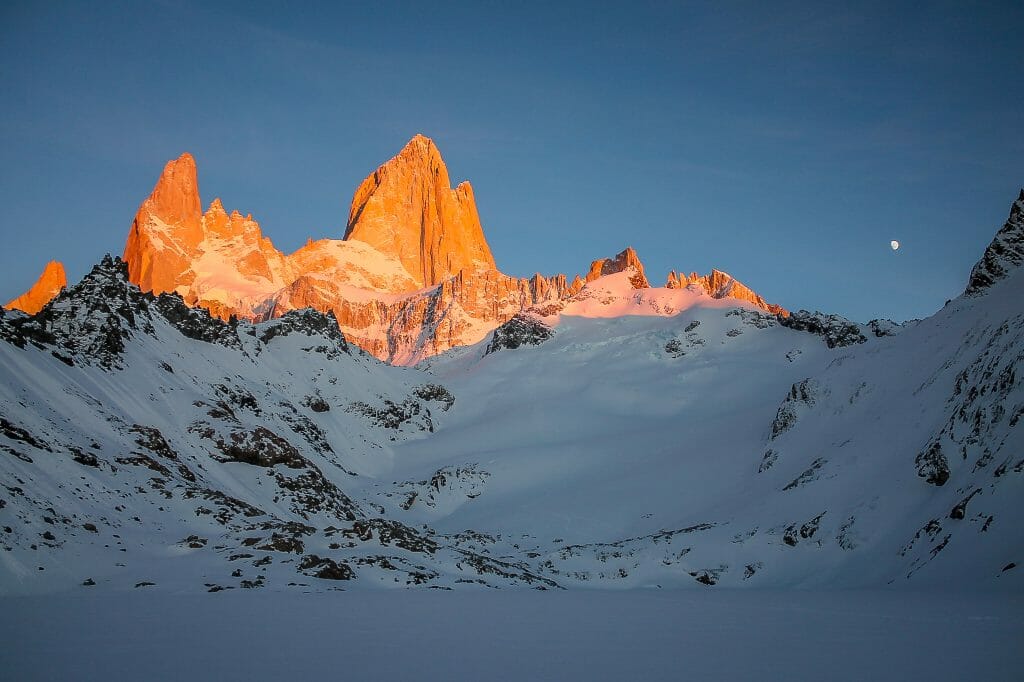
Twelve months became 20. Backcountry skiing expanded to mountaineering. Passion demanded everything at once: ski mountaineering. I was in love; I was obsessed. I wanted to go bigger, faster, farther, higher. But I wasn’t ready.
I remember the first time I watched someone seem to accelerate away from me on the mountainside. It was on the Skillet, April 21, 2018—a date etched into my mind. I stepped aside to let another skier who seemed about my age pass me. I remember initially thinking that I could keep up with him, no problem. Just pull it together and try a little harder. I remember watching his group of three pull farther and farther ahead on the slopes of Moran. I remember scooping snow into my helmet and putting it back on my head because I was too hot, too tired, too slow, and running out of water.
There were some dozen people out trying for the Skillet that day. My friend and I had been one of the earliest parties to start up the lower slopes of the glacier. Come sunrise, half of those who had started behind us were out in front of us. Only four people were fast enough to make it to the top safely that day. Only one was fast enough to make it up and down before the mountain came alive, before the sound of the roaring thunder.
It sure wasn’t me. I remember watching that one person snowboard past me. I was still plodding upward, the summit in sight but out of reach. I remember giving up, knowing I was too slow and it was too hot. I remember transitioning to ski down the slope. And I’ll never forget being swept down that slope instead by an avalanche of loose, wet snow from the cliffs above.
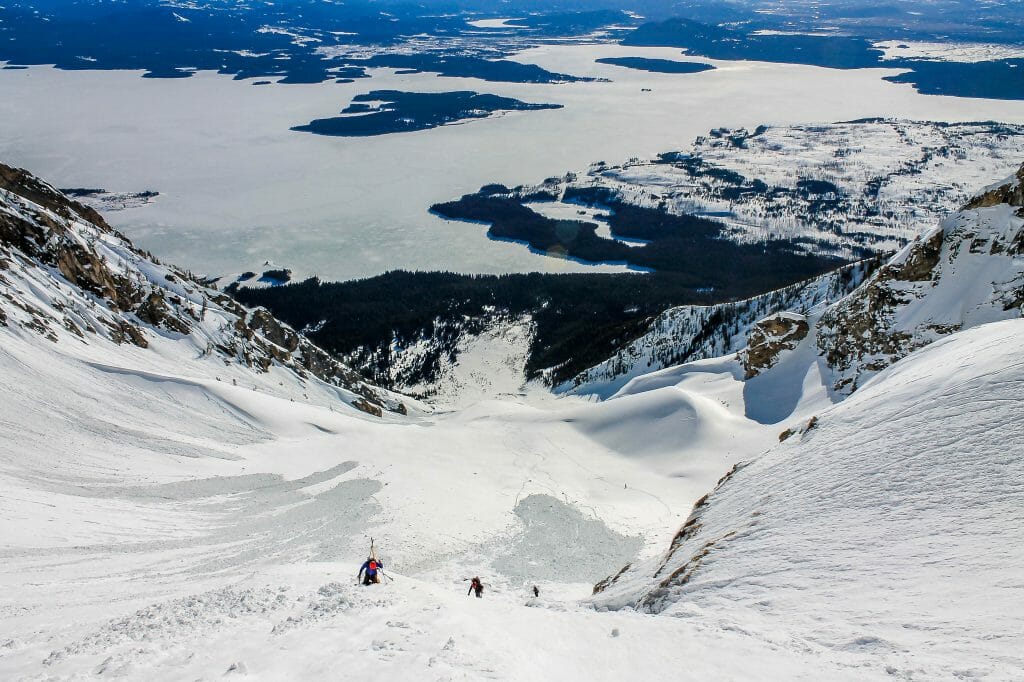
Fortunately for me, I managed to self-arrest a few hundred feet below the point of impact. My skis and poles were carried over 2,000 feet down onto the Skillet Glacier. Since I was walking, the three skiers who were still above me at the summit—the group that had passed me earlier—eventually caught me on the descent and helped me collect my things. My partner, not feeling well, had descended back to our camp some 30 minutes before. I contacted him on the radio to let him know that I had been swept, but that besides the bleeding cuts on my hands from my efforts to self-arrest, I was uninjured and coming down.
Training for the New Obsession
I made a lot of mistakes that day on the Skillet. Because there were so many other people out there, I figured it was safe. Because the glacier had so much wet slide debris on it already, I figured the mountain had shed its loose snow in previous days. Because it was only 10:30 a.m., I figured it was too early for a wet slide. Because I had invested so much time and effort coming across the lake and climbing the majority of the peak, I didn’t want to turn back. I learned that playing in the mountains comes with a lot of risk. And I learned that if I had been better prepared, I could have better mitigated that risk.
There are many factors at play and no way to control for them all, but speed equates to safety in the mountains, and it is a factor that you can control. If you reduce your exposure time to hazards, you reduce your risk. If you increase your ability to move quickly, you increase your margin of safety. I learned that day that if you show up for an objective and you aren’t physically prepared, you could pay the price. I learned that if I wanted to go on the adventure of a lifetime and come back, I had to take things more seriously.
I cracked open Training for the New Alpinism for the first time later that year. It must have been sometime around Thanksgiving because I remember being at home with my parents and excitedly describing my new knowledge. The key element that held my attention was not that Scott and Steve tell the reader exactly what to do; it was that they tell the reader exactly why to do it on a deep, fundamental level. I was mesmerized by the transparent and thoroughly explained physiology behind the training methods described in the book. The science fascinated me.
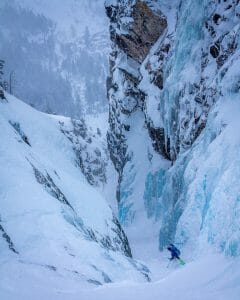
Flipping through the pages, I was reminded of the scene from Pumping Iron where Arnold Schwarzenegger compares the job of the bodybuilder to that of a sculptor. The job of the bodybuilder is harder, he says, because the sculpting has to be done on a living, breathing person. Reading Scott and Steve’s text opened my eyes to the fact that the body can indeed be molded to your desire; it can be fine-tuned to perform for the duration, intensity, and activity that you wish. But the body is an extension of the mind, and thus performance comes only through discipline and great mental effort.
I had my first phone call with Uphill Athlete coach Seth Keena-Levin on July 29, 2019. Some weeks after that initial call, I found myself on a bike path near downtown Boulder, not far from the storage closet I was renting as a room for the summer. I hadn’t eaten that morning—I was fasting to help encourage my body’s fat adaptation. In the peak summer heat of August, I was on one of my first training runs scheduled by Seth. And I was walking.
I was walking because between the heat and my low level of aerobic fitness, jogging was elevating my heart rate beyond my aerobic threshold, thus impeding the specific training effect I was looking for. As I walked along the cement path, I wondered if this could really be helping me prepare for tackling high peaks in faraway places, for withstanding ice and snow while hauling a heavy load on the mountainside.
I completed the workout as prescribed and went on to the next.
Make Your Own Adventure
A few months later, after returning from an autumn trip to Nepal, I asked a number of people to join me on an expedition to Denali in the spring of 2020. Sophia was the first to say yes. Ian took a bit more convincing (he would have to take a month off work), but since his boundless positivity is a priceless asset, I persisted until he gave in to temptation. The plan was to click into a pair of skis atop North America’s highest peak. By doing it as an independent team, rather than hiring a guide service, the three of us would take a tangible step forward in our ability to prepare for and execute serious adventures in high-stakes environments.
That plan was unceremoniously dismantled by the global health crisis.
Like many athletes in March of 2020, I was under a specific training load on a specific timeline for a specific objective that suddenly no longer existed. The world wasn’t ending; I was fortunate not to be sick or dying. But when you invest all of your time and energy into a single purpose, the loss of that purpose will take its toll regardless.
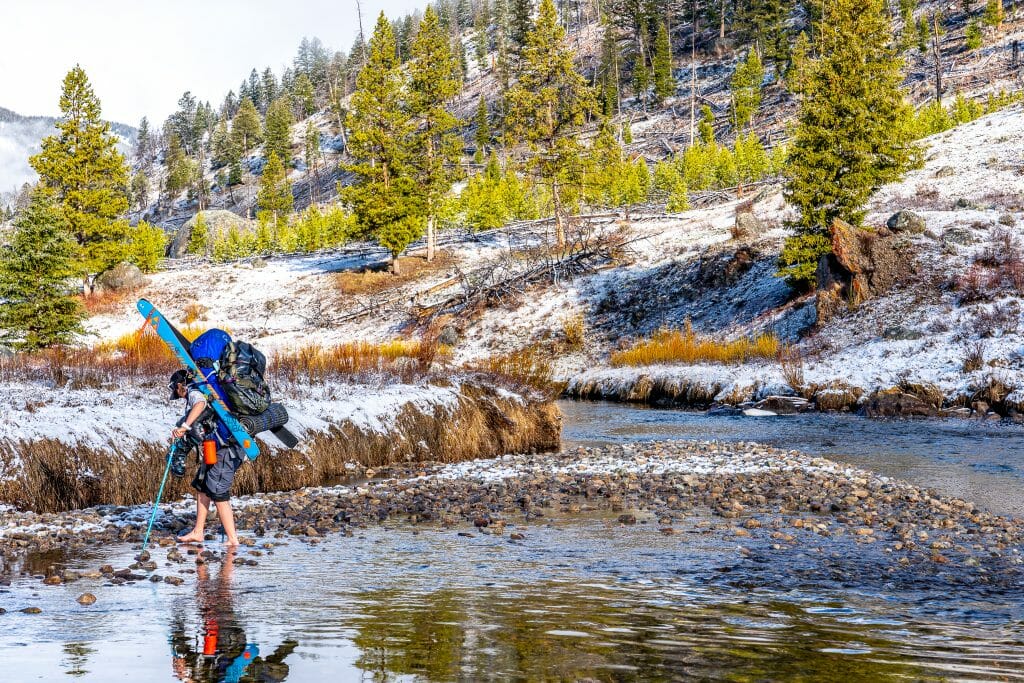
A loss of direction, however, can also be viewed as an opportunity. With a little creativity, that essential cornerstone of a meaningful life—to seek out new experiences, and in doing so challenge yourself and overcome—is always within reach. You may even find that creating and executing your own self-imposed challenge is ultimately more fulfilling than checking off a commonly accepted and oft-repeated standard of achievement.
The idea of trying to ski from the summit of Denali intimidates me, and it is with great anticipation that I still plan on going there one day. With that said, such a popular destination largely presents a list of obstacles that have been explained at length by those who have gone before. Pictures, videos, stories, and general advice regarding the peak are freely and widely available.
On the other hand, finding your way through an experience that is not well-defined can present a variety of unknowns that force you to problem-solve outside your comfort zone. A lack of clarity around what to expect and where you may find your limits is both the peril and the beauty of true adventure. With that in mind, I started looking for such an adventure in my backyard.
Into the Winds
The vast wilderness of the Wind River Range is just a two-hour drive from the town of Jackson. Protected by rolling foothills and a long approach through the trees, its remote beauty is overshadowed by the majesty of nearby Grand Teton National Park, whose sheer cliffs and awe-inspiring pinnacles seem to rise straight out of the valley floor. The Tetons beckon to serious adventurers and casual tourists alike. Most don’t realize that with the exception of the Grand Teton itself, the Winds hold 19 of the 20 highest peaks in Wyoming, including one of the least accessible state high points in the nation—the mighty Gannett Peak.
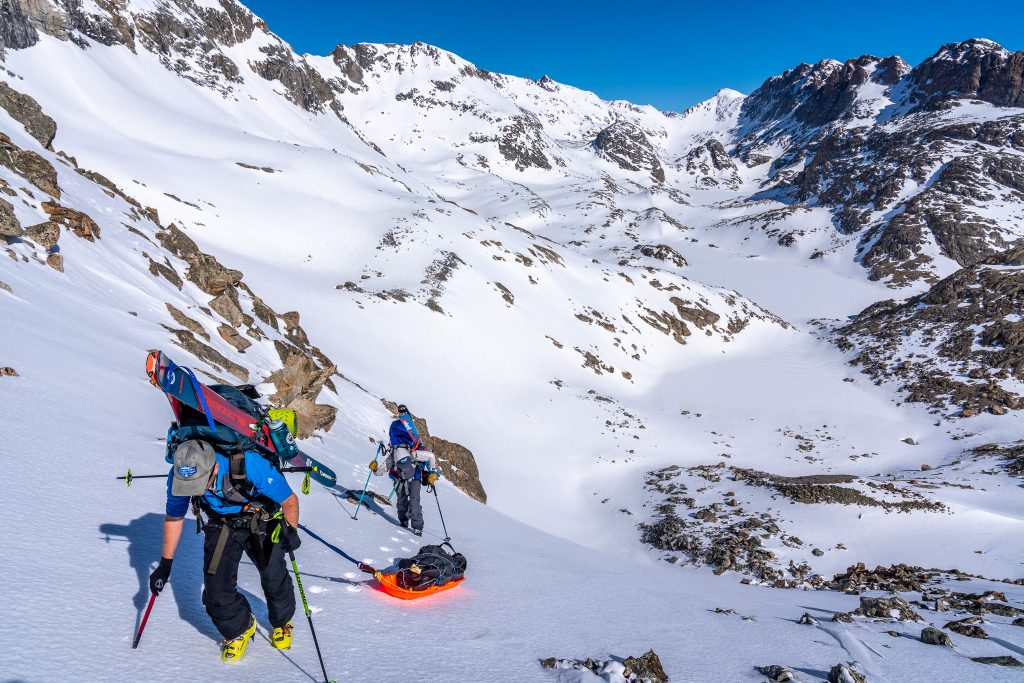
Though the range does see a fair bit of traffic from hikers, backpackers, and climbers in the summertime, skiing in the Winds is less common and typically limited to more well-known hotspots, such as Titcomb Basin and the Cirque of the Towers. Living in Jackson, I had heard the occasional story of dragging sleds into the Winds for a ski attempt on Gannett Peak, frequently associated with words like “long,” “slog,” and “heinous.” It was something a lot of people talked about doing, but few seemed to actually do. I was still training daily for an objective I no longer had, and this sounded exactly like what I was looking for—something with a distinct possibility of failure. Something that might push me and my stalwart companions to our wits’ end.

But a long weekend mission to ski Gannett wasn’t going to replace weeks in the tent on Denali. So just before a team phone call to discuss possible alternatives, I sent an email suggesting that we traverse the entire range on skis, and tag Gannett along the way.
Even before the execution stage, there were a number of challenges to traversing the Winds on skis. Not aware of anyone who had ever done this, we didn’t know whom to turn to for advice on conditions or the best route. We even speculated that it might never have been done before, until discovering that an experienced guide named Forrest McCarthy had completed it solo as part of a Lander-to-Jackson ski traverse back in 1994. Even so, beta was extremely limited online; just deciding which month to go in—April or May—was a matter of debate. I spent hours poring over Google Earth and Gaia attempting to plot a route that would make moving over mountain passes I had never seen—for days on end—a feasible endeavor.
Accessing the high alpine of the Winds presented its own problems. Spring offers the possibility of better weather, but with warmer temperatures and sunshine comes a rising freezing line. Reaching that line would involve slogging through rotten snow interspersed with rocky terrain and cold stream crossings, all within a heavily forested setting. Once in the mountains proper, we would encounter the largest concentration of glaciers to be found anywhere in the American Rockies. If the inhospitable terrain and sheer distance didn’t shut us down, springtime storms carrying heavy snowfall into the range might.
On top of the challenges presented by the environment, a traverse meant that there would be no base camp. We would either be packing up and moving ahead toward our goal, or falling behind schedule. Because we would have to carry all of our gear and supplies continuously through the mountains, we had to be very particular about what we brought with us, and be prepared to shoulder everything we did bring on a daily basis. Rather than carrying that load on a track set by hundreds of climbers on a popular peak in high season, we would have to make our own way.
In short, with the notable exception of extreme altitude, it offered many of the same challenges as Denali—and a variety of others to boot.
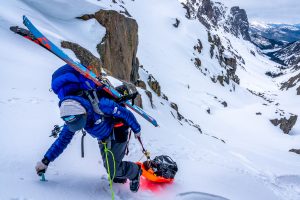
On May 2, we hired a local snowmobile outfitter to drop us off as close as we could get to the trailhead. As it turned out, that was about 9 miles northwest of where we had planned on starting; the day before we had left a car about 4 miles south of the exit trailhead. Adding 13 miles to the trip right off the bat was not ideal, but not unexpected. I remember the farewell we received from our new friend after we had unloaded our gear from the snowmobiles. “Well, I hope you come back alive.” Those were his exact parting words. We started walking, trying to decide if the snow patches were continuous enough to warrant clicking into our skis.
Traversing the range would prove to be a true test of all that we had prepared for. As the days rolled on, we built anchors on the mountainside to raise and lower our sleds or put team members on belay in exposed sections. We cut cornices after hauling food and gear to the tops of high mountain passes, only to find that they might be impassable. We skied 40-plus-degree slopes with full 85-liter packs on our backs and no poles, because both hands were occupied holding a sled with a hundred-liter duffel bag strapped to it.
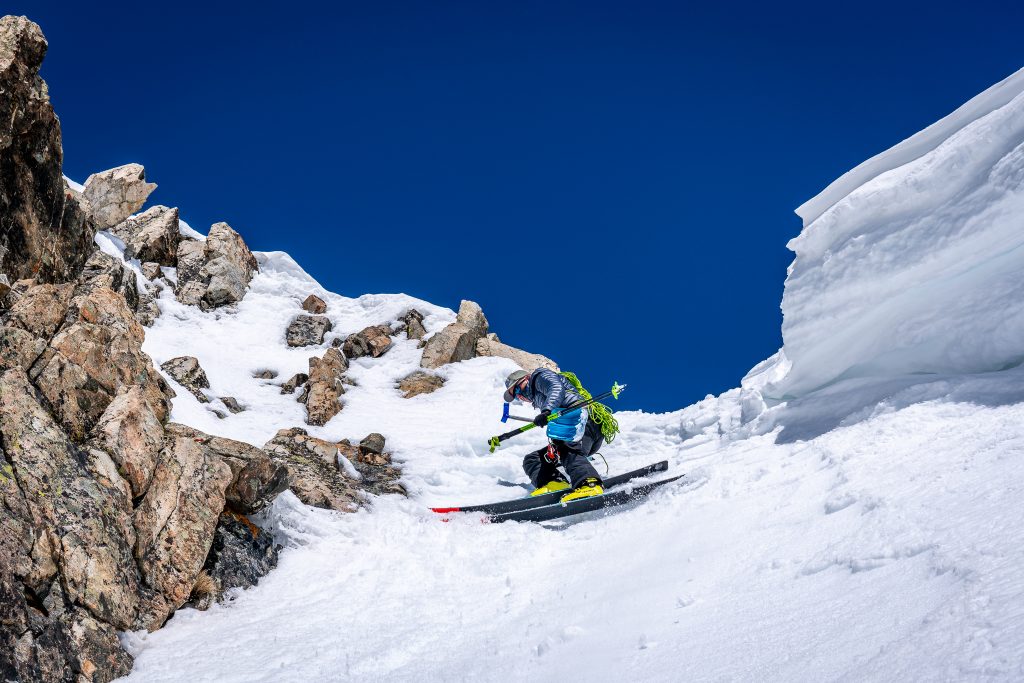
We debated where to set up camp when thunder and lightning punctuated the falling snow, roiling black clouds closing in above jagged granite peaks. We shouldered our skis and downclimbed when there was just no way through. When the latest weather event caught us from behind, tempestuous winds bombarding us with snow and ice, we hurried to ski into the relative safety of the valley. And we made lots of noise each time we passed fresh grizzly bear tracks in the snow. There was no one out there to tell us which way to go or how to handle any given situation, no one to turn to for support but each other.
Most importantly, each evening we had to be ready to do it all again the next day. We had to be ready to step back into the snow every morning at 6:00 a.m. and keep going. In 13 days spent crossing mountains on foot, we never took the rest day that we kept discussing, instead dragging our beloved sleds until the waning sun and imminent nightfall would herald a hot meal and warm sleeping bag. On the final day, after much back-and-forth about the best route through rotting snow, fallen timber, open water, and the freshly liberated rock bands of the low foothills, we slowly but surely slipped into a 24-hour, 20-plus-mile push out of the mountains and back to Jackson.
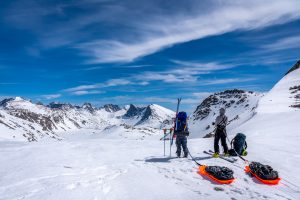
And so it was that just after midnight on the morning of May 15, ski boots caked with mud and sleds strapped haphazardly to our packs, we concluded our adventure in some of the worst conditions of the trip, route-finding and creek-crossing in the dark for the last few miles to the trailhead. The whir of the air conditioning and the sound of heavy rock ’n’ roll pouring out through the open windows of the car we had parked at the southern end of the range was sweet salvation.
In the end, the touted remoteness of this vast wilderness right on our doorstep did not disappoint. Not once in nearly two weeks traveling the length of the Wind River Range did we encounter a single other person; we couldn’t have found that sort of solitude on Denali. By the time we made our way across the range—with a bit of backtracking and one pit stop to climb and ski Gannett—we had covered more than 115 miles and 32,000 cumulative vertical feet of ascent on foot. And even though it’s satisfying to quantify the result of our efforts, those numbers can hardly encapsulate the long days spent exploring the great expanse of untamed forestland, the windswept mountain passes in deep snow, the burbling streams along the valley floors, and an endless array of towering granite peaks.
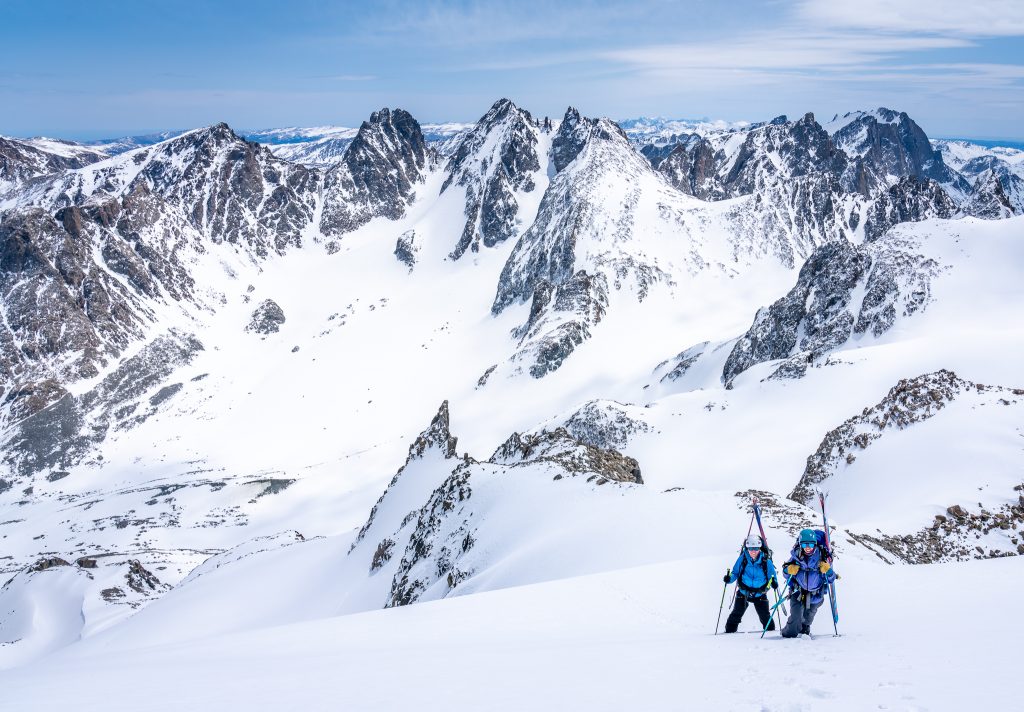
The Next Hill Is Earned
In the run-up to those first steps down a dirt road in well-worn ski boots, I had spent over seven months training six days a week with Uphill Athlete. Training was my first priority; paying the rent was second and everything else came third. Each day I would upload the heart rate data, distance covered, vertical feet gained, number of reps and sets, total time, and comments on my various workouts, and each day I would receive feedback from Seth on my progress and the work to come. I knew the purpose of each workout—aerobic base, muscular endurance, strength, explosive power, coordination, flexibility, recovery—and I could see the path before me, leading me ever onward in the direction of my mountain hopes and dreams.
A few of those training days involved skiing lines at the top of my hit list in Grand Teton National Park. A few of those training days involved having the time of my life and experiences that I’ll cherish for years to come. Most of those training days did not. By midwinter, my friends were asking me how many laps I had put in on Snow King, the local ski hill behind the town of Jackson that offers uphill access and about 1,500 vertical feet per lap. Since I was putting in three or four laps a day sometimes, I didn’t know how many I’d done and didn’t really care to count. And I won’t remember any particular lap I did on Snow King. But each and every one was worth it.
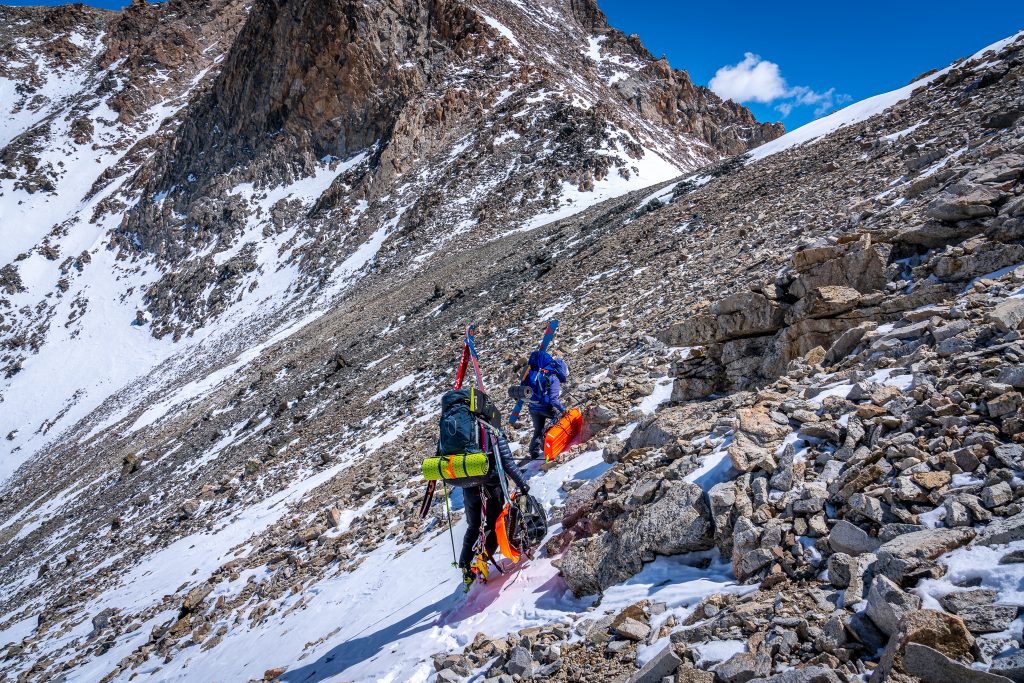
In the introduction to Training for the New Alpinism, you’ll find these words: “Training is the most important vehicle for preparation. Constant practice begets examination and refinement of technique as well as fitness. It is not our natural tendency to value struggle over success, a worldview that climbing sternly enforces.” In other words, when it comes to training, one of the most difficult aspects can be sacrificing immediate gratification in exchange for a long-term, repetitive grind. This is especially true when you are making that trade in pursuit of a dream that may never be realized. I find that this mental challenge applies broadly to life.
You may think it’s not as fun to put in countless slow, aerobic laps up and down the local hill by yourself as it is to go ride the lifts and shred powder with your friends. You may not think reading an educational book is as fun as lying on the couch watching Netflix, or going out to party night after night. I certainly don’t. But when you look back on your life, will you realize that you too often chose what was fun and easy in the moment? Will hindsight reveal that you rarely had the fortitude to forgo immediate pleasure for a chance at something greater, something worthwhile? Will you regret that you never truly put in the hard work that was necessary to have a shot at realizing your wildest ambitions? These are questions that I often ask myself.
When I reached the bottom of the Skillet on March 23, 2020, I discovered that my dream of skiing from North America’s highest summit within three years of learning to ski was no longer a possibility. But when I reached a hot shower and my own bed around 5:00 a.m. on the morning of May 15, I had satisfied the fundamental purpose at the heart of that dream—an unforgettable adventure with irreplaceable friends. As I curled up under the covers that morning, half of my fingertips were cracked and bleeding from prolonged exposure to the cold mountain air. The rest of my body was without so much as an overuse injury or a strain. A few hours of sleep later, I cracked open my laptop and sent an email to Seth about when we could resume the training. After all, reaching the top of the next hill is earned—not given.
